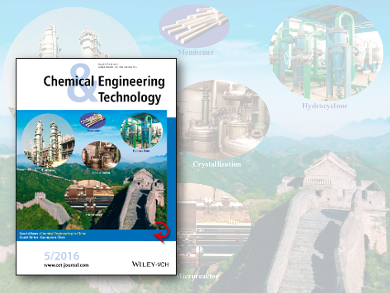With China already being the world’s biggest chemical market, there is still much potential for expanding research and development. And although funds and staff are not yet optimal, China has come a long way in the last 30 years.
The country’s chemical industry is becoming more environmentally conscious. Sustainability is becoming a core part of many businesses since it not only reduces environmental impact, but also provides a possibility to reduce costs. This goes along with the evolution of industrial standards to provide high efficiency, safety, and controllability, both for the environment and the people.
A special issue of Chemical Engineering & Technology highlights some of these recent efforts and developments and provides a general overview of the current trends in chemical engineering in China.
As the guest editor Guangwen Chen, Dalian Institute of Chemical Physics, China, mentions in his editorial [1], academia and industry have successfully joined forces to overcome the challenges posed by low process efficiency, high energy consumption, heavy pollution, poor process safety, and poor product quality. A re-thinking of the future direction is taking place in the chemical industry and the concepts of process intensification and multi-scale methodology have increasingly been applied.
Topics of the special issue include microreactor and membrane technology, nanomaterials, catalysts, and kinetics, as well as process simulation and process intensification.
In their review, Junbo Gong and colleagues, Tijanjin University, China, discuss the latest developments in industrial crystallization [2]. Crystallization is applied in a variety of industry branches, such as in the fertilizer, pesticide, petrochemical, biochemical, catalys,. and electrochemical industries, to name just a few. However, the current trend in China mainly focuses on the production of inorganic salts, pharmaceutical crystallization, and process optimization in the food industry. According to the researchers, the future lies in the refining of low-end to high-quality products. More basic research needs to be done, which will then automatically lead to new developments in industrial applications up the process chain.
Distillation technologies have been used in China since the 1950s. It is even reported that the art of distillation originated there at about 800 B.C. A review by Xin Gao and colleagues, Tianjin University, covers state-of-the art equipment for distillation processes as well as simulation models used to control and optimize them [3]. The researchers also describe current efforts towards developing green distillation processes, which include not only energy conservation but also process intensification to increase the efficiency.
To summarize, China is becoming a major player in the world’s chemical industry by focusing its innovation potential on establishing research and development facilities as well as increasing the efforts to develop sustainable and environmentally friendly processes.
- Special Issue: Chemical Engineering in China,
Chem. Eng. Technol. 2016, 39 (5).
References
- [1] Chemical Engineering in China,
Guangwen Chen,
Chem. Eng. Technol. 2016, 39, 806.
DOI: 10.1002/ceat.201690025 - [2] Industrial Crystallization in China,
Junbo Gong, Yan Wang, Shichao Du, Weibing Dong, Bo Yu, Songgu Wu, Jie Hou, Jingkang Wang,
Chem. Eng. Technol. 2016, 39, 807–814.
DOI: 10.1002/ceat.201500718 - [3] State-of-the-Art of Advanced Distillation Technologies in China,
Hong Li, Yan Wu, Xingang Li, Xin Gao,
Chem. Eng. Technol. 2016, 39, 815–833.
DOI: 10.1002/ceat.201500656
Also of Interest
- The Future of Distillation – Industries’ Most Energy-Intense Technology,
Andrzej Górak,
Creator Space February 18, 2015.
A. Górak, TU Dortmund, discusses opportunities on how to improve the energy consumption and efficiency of distillation




